In the intensive care unit of the hospital where I work (the University Medical Center Utrecht), we rely on a Patient Data Management System (PDMS) called MetaVision. This system stands out for its exceptional configurability, making it an invaluable tool. With MetaVision, we have the ability to define and fine-tune various aspects, allowing for a truly customized system. The fundamental building block of this system is a parameter, which can be displayed and utilized across menus, graphs, tables, forms, and more. These parameters can store various data types, including text, numbers, dates, and more. Additionally, VB.NET scripts can be employed to further enhance and extend the functionality of these parameters.
“Customizing MetaVision from scratch feels like reinventing the wheel with each parameter and associated functionality, despite its remarkable flexibility.”
However, a drawback of this system is the need to individually create and configure each parameter, along with all associated functionality. Although MetaVision offers remarkable flexibility, customizing the system from scratch demands significant effort. Furthermore, in intensive care units, there is a notable recurrence of similar requirements for parameters and their usage. For instance, configuring a parameter for heart rate is necessary in virtually all MetaVision implementations. This repetitive process often feels like reinventing the wheel time and again.
This issue has become increasingly relevant at our hospital, as we recently faced the need to upgrade from our old MetaVision 5 to the entirely new MetaVision 6 version. Complicating matters further, we maintained separate databases for the adult ICU and the Pediatric and Neonatal ICU. This necessitated the merging and manual copying of each item from the old configuration to the new MetaVision setup. To streamline this process, I took the initiative to develop a MetaVision Copy tool.
The primary purpose of this tool is to facilitate the transfer of configuration elements from one database to another. Additionally, it possesses the capability to copy MetaVision version 5 objects to a version 6 database. At present, the tool is capable of successfully copying over the following items:
- Parameters
- Units (including DripUnits)
- Forms
- Statements
- Sequences
- Tabular views
- Graph views
The development of the tool aims to expedite the transition to MetaVision 6 and reduce the manual effort required for configuration migration.
The tool operates in the following manner: First, a connection is selected to establish a connection with the source database. From this source database, the desired configuration objects mentioned above can be chosen. Depending on the selected object, the tool generates an “insert script” in the form of regular SQL code. This script can then be executed on a target database. The insert script ensures that existing entities in the target database are utilized, and if needed, new entities are added to the database. To ensure a seamless process, it is advisable to use a backup of the target database for testing the script. This allows for any necessary adjustments to the imported object’s configuration based on the functional requirements and the current configuration of the target database.
So, in general the following workflow will be employed using this tool:
- Select the source database
- Select an object of interest to be imported
- This creates an insert script (regular SQL code)
- Run the insert script on a copy of the target database
- Test and adjust the object in the target database
- Create, again, an insert script for the object in the copy of the target database
- Test the insert script and make sure no additional configuration is needed
- Finally, run the insert script on the target database (or for the final step copy over the object manually)
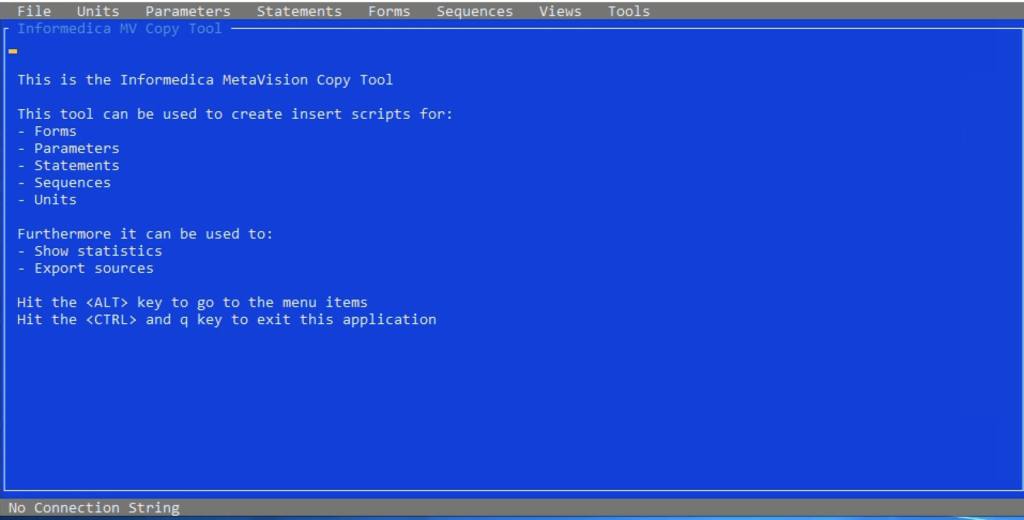
The tool is designed as a straightforward command line application, enabling effortless installation on any Windows machine without the requirement of complex install scripts or additional dependencies. Simply copying the application binaries to a directory allows for easy execution of the tool.
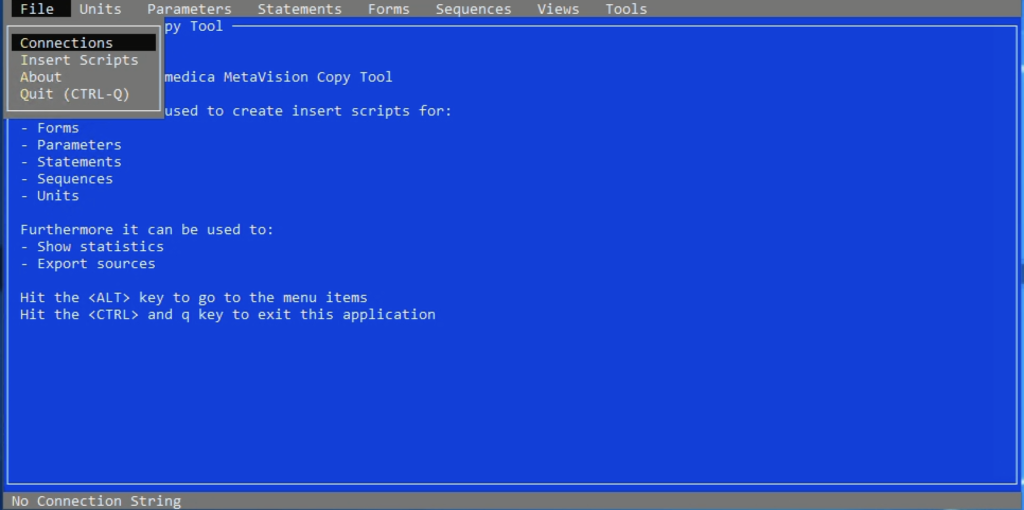
The tool leverages a “settings file,” a text-based configuration file that facilitates the definition of connection strings for the databases. By utilizing these connection strings, the tool can establish connections with various MetaVision databases.

After establishing a connection, the tooling can assist in generating “insert scripts” for different configuration objects, such as parameters, units, forms, and more, encompassing all their associated dependencies. These insert scripts streamline the process of creating and configuring the desired objects within the MetaVision database.
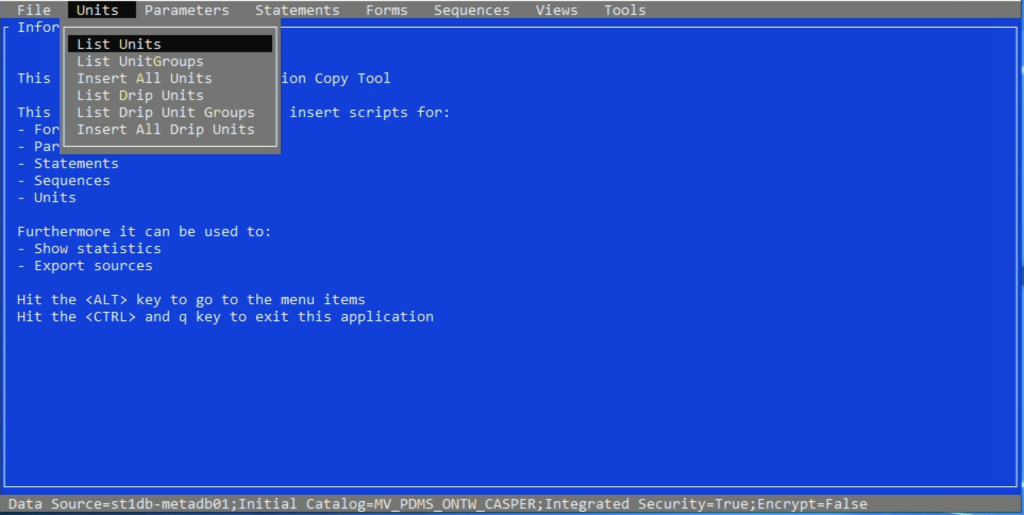
Each menu item gives different options to select a single object or grouped objects. When there is a list of objects, a single item from that list can be selected to create an insert script.
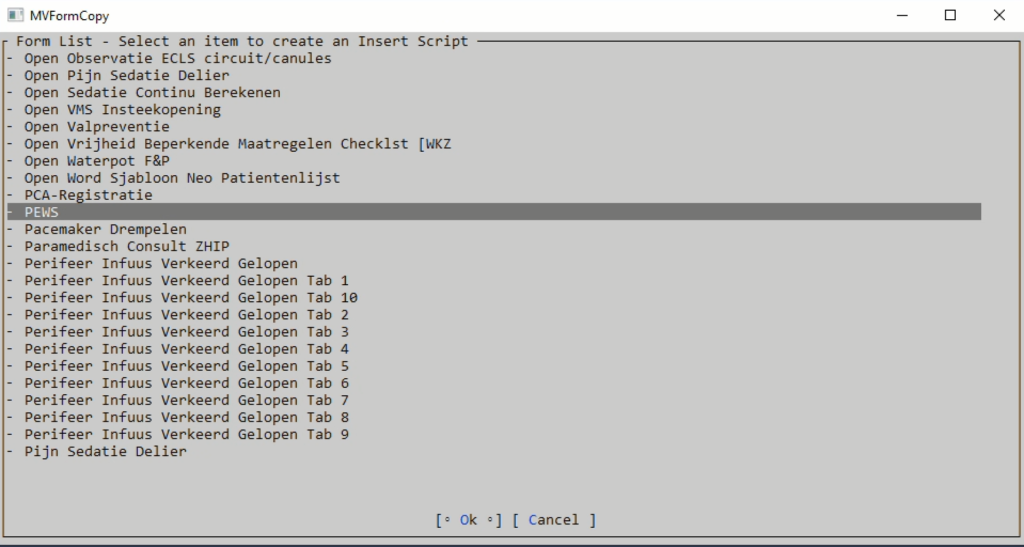
As an illustration, suppose we aim to duplicate a Pediatric Early Warning Score form, including all associated scripts and entities. By selecting the desired item and clicking “Ok,” the script will effortlessly insert an identical copy of the form.
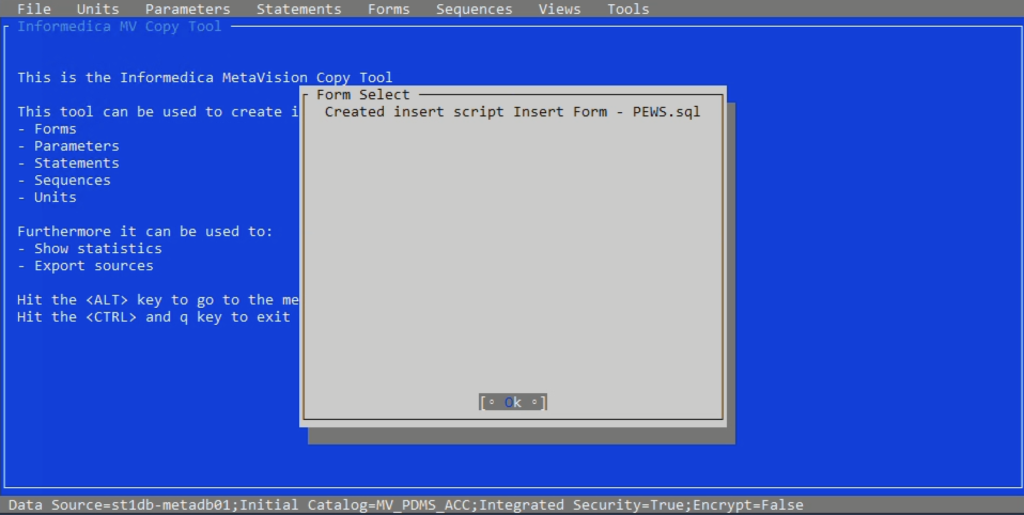
The script can than be run in transaction mode on any MetaVision 6 database:

Once it has been confirmed that the transaction has been executed successfully, it can be rerun in “commit mode” to seamlessly insert the entire form without encountering any issues.
As a testament to the tool’s practical reliability, it has been utilized to successfully transfer all forms from legacy MetaVision 5 databases to the new MetaVision 6 database. Furthermore, it has also been employed to seamlessly copy all forms from our development database to the final production database, demonstrating its effectiveness without encountering significant issues.
Conclusion
In conclusion, MetaVision proves to be an invaluable Patient Data Management System (PDMS) in the intensive care unit of our hospital, offering exceptional configurability and customization options. While there may be challenges in individually creating and configuring each parameter, the flexibility and functionality provided by MetaVision make it a powerful tool for tailored healthcare solutions. The development of the MetaVision Copy tool has further enhanced the migration process, allowing for efficient transfer of configuration elements between databases. With its simple installation and reliance on a settings file for database connections, the tool offers a user-friendly experience. By generating insert scripts for various configuration objects, including forms and their associated dependencies, the tool streamlines the process of replicating and adapting them in target databases. With successful implementations in upgrading MetaVision versions and copying forms between databases, the tool has proven its reliability and effectiveness. Overall, MetaVision and the accompanying tool facilitate efficient customization and configuration in the intensive care setting, contributing to improved patient care and data management.
![]()
